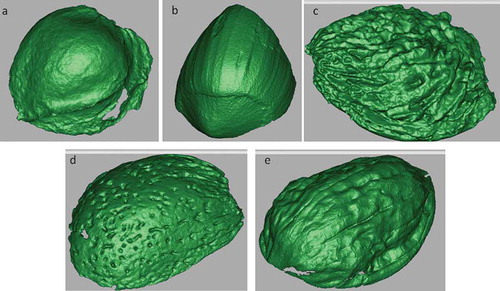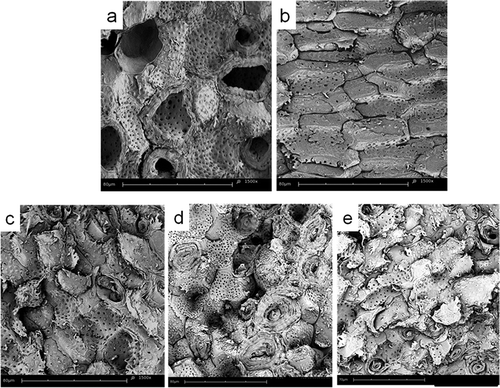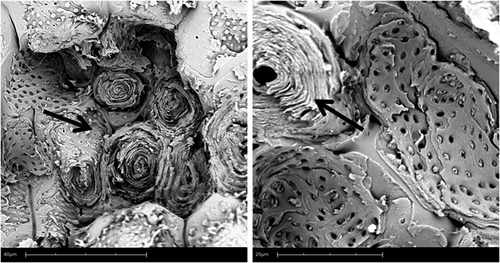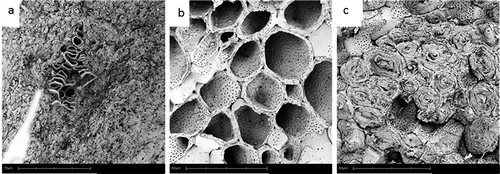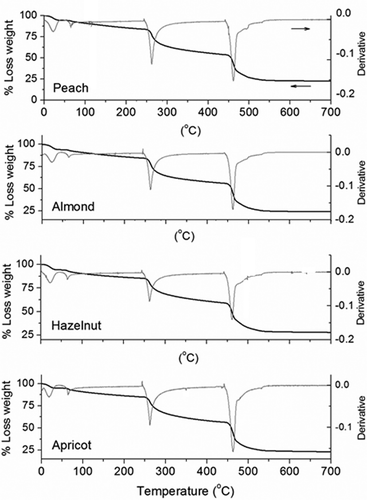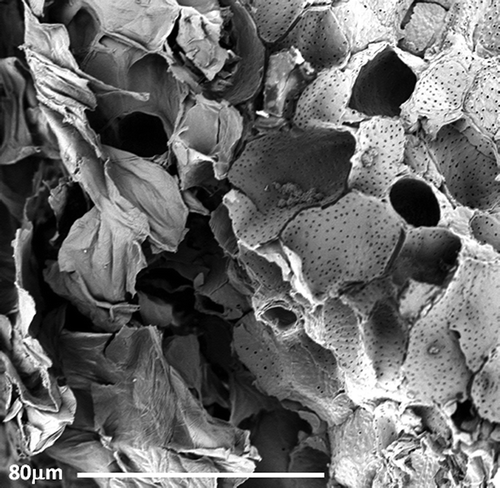Abstract
The microstructural, thermal, and nanomechanical characterization of biomass by-products coming from the food industry were studied. Scanning electron microscopy showed a microstructure formed by polygonal grains. The thermal behavior of seeds, evaluated by thermogravimetric analysis, revealed three main components (hemicellulose, cellulose, and lignin). Walnut shell showed the highest thermal stability and also the highest amount of lignin. The nanomechanical aspects were evaluated by nanoindentation. Samples with higher amount of cellulose presented minor modulus values. In accordance with the thermal stability, the highest modulus and hardness were observed in walnut. These by-products could be useful as reinforcement materials for biodegradable plastic industry.
INTRODUCTION
There is renewed interest worldwide in the production of biodegradable plastics to reduce the environment damage produced of plastic wastes, particularly from the food packaging sector. However, in general biodegradable plastics present low mechanical properties[Citation1Citation−Citation3] which hinder its practical exploitation. Cellulosic materials coming from renewable resources obtained from agricultural industries have gain importance as potentially reinforcement elements of biodegradable thermoplastic materials.[Citation3Citation−Citation5] Moreover, crop-derived biomass is considered as one of the most promising renewable resources to substitute petrol-based materials.[Citation6] In this sense, the wood structure found in nature is well known and their architecture and chemical characteristics are published elsewhere.[Citation7] Materials from wood origin are composed of three main cell wall polymers: cellulose, lignin and matrix polysaccharides (pectins and hemicelluloses).[Citation4] Wood structure is basically resumed by tubes of crystalline cellulose linked by means of an amorphous phase composed by hemicelluloses and lignin. The mechanical properties of a wood structure are also reported for each analyzed sample and an important feature in this sense is their anisotropy.
Nevertheless, although other cellulosic bio-materials extracted from secondary industry are also formed basically by wood, the internal architecture is expected to be different. The fruit’s seeds are a good example of how nature can develop other internal microstructures in order to adapt their requirements using the same chemical composition than wood. It is expected that understudying the microstructure, chemical composition and some mechanical properties inside of a fruit’s seed, new applications and uses can be found for this current wasted material. Moreover, it is known that several seeds have bioactive compounds that are beneficial for human health.[Citation8] Recently, many biodegradable polymers incorporated with natural compounds have been proposed as active food packaging systems.[Citation9Citation−Citation11]
It has been reported that wood as a reinforced material of thermoplastics shows some advantages such as good mechanical properties,[Citation5,Citation12,Citation13] low density, ease of separation, enhanced energy recovery, it inherent biodegradability,[Citation4] and low cost.[Citation13] Moreover, regarding food packaging barrier properties, the incorporation of cellulose nanostructures into polymer matrices improve the oxygen barrier properties,[Citation14] while the low hygroscopicity of cellulose materials could decrease the water vapor permeability.[Citation5] Some fruit’s seeds represent a large amount of byproducts and wastes that are biodegradable and could be used for the development of new biodegradables bio-composites[Citation15CitationCitationCitation−Citation19] which can be treated with organic waste after their use[Citation20] becoming environmentally friendly. For instance, pine wood flour has been added to poly(lactic acid; PLA) and poly(hydroxyalcanoates) (PHA) blends improving the mechanical performance of the final formulations.[Citation21] Sawmill residues from different wood such as spruce, pine, beech, and poplar has been successfully incorporated as flour in thermoplastic starch (TPS) increasing the mechanical response and thermal stability and decreasing the water absorption with respect to neat TPS.[Citation22] The mechanical microstructure properties of cellulosic materials have been well studied[Citation23] and it is known that wood presents excellent mechanical performance.[Citation24] The morphological structure of seeds is prepared to protect it from falls, knocks, bites, etc.[Citation25] Therefore, it is expected that seeds present good mechanical properties as reinforced materials. Some studies of the nanoscale mechanical behavior of some wood materials have been published[Citation26CitationCitation−Citation29] showing that hardness (H) and elastic modulus (E) determinated by nanoindentation seems to be useful to study the nanomechanical properties in specimens that are highly non-uniform.[Citation30,Citation31]
The aim of this work is to study the microstructure of Juglans regia (walnut), Corylus avellana (hazelnut), Prunus armeniaca (apricot), Prunus persica (peach), and Prunus dulcis (almond) by means of microscope images. Furthermore, the thermal stability and the mechanical properties were analyzed by using thermogravimetric and nanoindenter analysis with the main objective to propose these waste materials from the food industry as biodegradable reinforcing materials for plastic industry.
MATERIALS AND METHODS
Samples Preparation
Several Juglans regia (walnut), Corylus avellana (hazelnut), Prunus armeniaca (apricot), Prunus persica (peach), and Prunus dulcis (almond) were obtained from the agriculture industry in the area of Alicante, Spain. It is known that the moisture content is one of the most important factors affecting the strength of seeds,[Citation32] therefore samples were conditioned before testing in a box at 30% relative humidity for one year. Then silica gel was introduced into the box one week before analysis to ensuring the same humidity level. The humidity was controlled by a hygrometer. Cross-sections of each sample were obtained by using a diamond knife under dry conditions. The chemical composition of some of these structures has been previously reported[Citation33,Citation34] and seems that lignin content is higher in walnut (≈60%), followed by apricot (≈50%),[Citation35] hazelnut (≈40%),[Citation33,Citation34] and almond (≈30%).[Citation33] Meanwhile, cellulose content is approximately 50% in almond and 25% in walnut, hazelnut,[Citation34] and apricot.[Citation35]
3D Model
To acquire 3D images of seeds samples a 3D Optical Reveng Dental scanner (Open Technologies SRL, Brescia, Italy) was used and 20 surface acquisitions were taken. 3D surface meshes were made by using Optical RevEnge Dental 1.5 software.
Scanning Electron Microscopy (SEM)
The microstructures were observed by means of a SEM PhenomTM® of the FEI company, (Eindhoven, Nederland), with an accelerating voltage of 15 kv. The images were acquired on their cross-section after gold metallization in vacuum conditions prior to each analysis in order to increase their electrical conductivity. The fracture of samples for this analysis was performed at room temperature using a special hammer. The images were then analyzed by the shareware software of image analysis “Image J.”[Citation36]
Thermogravimetric Analysis (TGA)
TGA tests were carried out using TGA/SDTA 851e Mettler Toledo Thermal analyzer (Schwarzenbach, Switzerland) equipment. Approximately 8 mg samples were heated under oxygen and/or nitrogen atmosphere depending of the experiment performed. Two experiments were carried out dynamic and isothermal analysis. Dynamic TGA were heated from 30 to 700°C at a heating rate of 10°C min−1 under nitrogen atmosphere (flow rate 30 cm3 min−1). In the case of the second type of TGA analysis, two sequences were tested for each specimen. The first step was a heat ramp at 10°C min−1 from 30 to 700°C under oxygen atmosphere (flow rate 30 cm3 min−1). During the second step was performing several isothermal steps between the observed transitions during 30 min.
Mechanical Properties
A nanoindenter G-200 of Agilent Technologies was used to measure the hardness and modulus on the cross-section polished specimens. The experiments were carried out at a constant 1000 nm indentation depth using a Berkovich indenter on the basis of a previous developed method.[Citation37] The stiffness was acquired during the entire load curve using the continuous stiffness measurement (CSM) method. Samples were kept in a box for a year at a constant 30% humidity previous to the indentation experiments. Cellulose-based materials are strongly influenced by the environmental humidity.[Citation38] Therefore, in order to perform the experiment with the same humidity conditions, silica gel was introduced inside the cabinet of the nanoindenter for a week ensuring the same humidity level by hygrometer.
RESULTS AND DISCUSSION
3D Surface Acquisitions
3D Scanning surface of samples allow observing some differences in surface details () between different seeds. Final surfaces meshes constructed from the scanned image consist in 402,010 points for walnut, 129,603 points for hazelnut, 103,953 points for apricot, 276,541 points for peach, and 229,621 points for almond. It is clearly noticeable that samples presented different surface structure showing high differences in roughness which could influence the mechanical response of each material. Peach was the roughest sample followed by walnut and almond, meanwhile hazelnut and apricot seem to present smoother surfaces.
Microstructure Analysis
In order to study the constituent microstructure of the specimens SEM images were acquired on the cross-section view after a brittle fracture. shows the most representative images recorded for each specimen. The first conclusion is that, although the studied specimens are cellulosic materials, the images reveal that the structures are formed by polygonal grains instead of the typical tube-fibrils forms of the wood structures. This microstructural difference probably leads to a major isotropy behavior under mechanical efforts. Furthermore, the size, the density, and the wall thickness of the grains seem characteristic for each analyzed sample. While the apricot, peach, and almond structures are formed by open grains, the hazelnut shows closed structure. These closed grains, it could be due: (1) to the major density of the grains or (2) because the fracture occurs by the adhesion fall between the interface grains. In order to compare rigorously the parameters that define these microstructures, the captured images were analyzed by software of image analysis, Image J. The results obtained after this analysis are summarized in . The almond shows grains with walls of cellulose especially thick that are formed by thin rolled sheets, as it is shown in . This structure is more representative in mature specimens, being the wall thickness of these specimens thicker than those from the youngest almonds as shown in . Thus, during the maturation of the almond, the cavities of the grains are controlled by rolling new sheets. This change in the cellulosic microstructure permits the seed to adapt at the required necessities for each maturity stage.
TABLE 1 Summary of the Calculated Microstructure Dimensions
Thermogravimetric Analysis
Thermal degradation of biomass by-products was studied by TGA. Dynamic TGA curves () for all samples showed similar behavior of three events. They began with a water loss event at the beginning of the experiment up to about 205°C (Region I). Following that, two main events of mass loses, Region II and Region III. summarizes the corresponding weight loss with the temperatures at the maximum degradation rate (Tmax) of each temperature interval region, which were determined from derivative curves (DTG). Region I, related to the evaporation of absorbed and bound water in their structure, presented values between 0.8 and 4.6%, showing that peach was the sample with most water content, meanwhile apricot showed the lowest value. Region II was related to the thermal degradation of hemicellulose which completes its decomposition at temperature intervals of 210–325°C.[Citation39,Citation40] Walnut and apricot presented higher percentage of weight loss in the Region II than apricot and peach, showing that these samples contain more amount of hemicellulose. The followed event (Region III) was between 330–450°C and it was related to the weight loss of cellulose. The percentage weight loss relates only with this region reveal similar values (between 23–25%) for apricot, peach, and hazelnut meanwhile it is lower (approximately 18%) for walnut, indicating that these three samples, apricot, peach, and hazelnut, contain more amount of cellulose than walnut. Lignin has a continuous weight loss from the initial to the end of pyrolysis in the TGA[Citation41] since the degradation of lignin occurring in a wide temperature range (100–900°C).[Citation7] However, some losses from lignin occur at temperatures higher than about 370°C, so DTG curves of lignin and cellulose may overlap and therefore it could be difficult to distinguish them.[Citation40] All samples reveal similar residual chars, between 25.6 and 28.4% related with the inorganic matter content. Dynamic thermogravimetric analysis showed that all seeds were substantially thermally stable in the region below 200°C, which is enough extrusion and film process temperature of the most used biodegradable materials in food packaging applications such as poly(lactic acid) PLA,[Citation10,Citation14] starch,[Citation42] chitosan,[Citation43] poly(hydroxybutirate) PHB or poly(hydroxyutyrate-co-hydroxyvalerate; PHBV).[Citation44]
TABLE 2 Thermogravimetric Parameters of Seeds Samples
Since, the thermal stability of cellulosic materials is governed by the composition of the two main components: Cellulose and lignin, the thermal degradation treatment of samples was carried out by using isothermal analysis. By means of a thermogravimetric analysis is also possible to analyze the composition between cellulose and lignin. The TGA was programmed with a heat ramp at 20°C/min holding three isotherms at 240, 300, and 600°C, during 30 min. These isotherms were programmed in order to separate enough the curves for each component and were established from the previous tests ().
The resulted TGA curves are summarized in and the temperature ranges have been summarized in . All the degradation curves had similar behavior. Two mechanisms are clearly differentiated; the first peak occurred around the 250°C that is related with the lignin degradation, and the second degradation was reached at 400°C that has been probably caused by holocellulose (that is a mix of cellulose + hemicelluloses). This conclusion was corroborated by observing the microstructures after the isothermal step at 300°C maintained for 30 min. shows the almond microstructure after this isotherm treatment. This image shows how the grains of cellulose are entire, but the grain boundary that serves to fix them (the lignin) has disappeared.
TABLE 3 TGA Results When Oxygen Atmosphere is Used. The Transition Region Corresponds to (I) Water Desorption, (II) Chain Scission, and (III) Degradation Mechanism
Mechanical Properties
As the materials essayed have no isotropic behavior, the choice of the Poisson’s ratio used in the Young’s Modulus calculation is not ascertainable at all. The Young’s Modulus calculated by nanoindentation has nothing in common with the modulus from a tensile test and the elastic behavior in wood based materials, because the evaluation of indents is carried out using isotropic indentation theory.[Citation45] Consequently the term “Young’s Modulus” as frequently used to describe the nanoindentation results would be here incorrect. For this reason, in this work the elastic modulus is calculated as indentation modulus, Er. The resulted curves for hardness and nanoindentation modulus are showed in .
FIGURE 8 (a) Nanoindentation hardness curves and (b) nanoindentation reduced modulus curves for the essayed specimens on their polished cross-sections.

The hardness values oscillated from the 200 MPa, for almond and apricot microstructures until the 450 MPa of the walnut. The modulus presented fewer differences being the lower 5 GPa for apricot and the highest 9 GPa for walnut. Apparently, the microstructure of the most differentiated specimens is very similar and we cannot identify their effect on the mechanical properties. The highest modulus found for walnut is in good agreement with TGA results, since walnut was also one of the samples with the highest thermal stability (370°C). The lesser values of hardness showed by apricot, peach, and hazelnut could be related with the higher amount of cellulose that these samples contain (approximately 23%) commented previously on TGA results. Nevertheless, it seems that the chain scission of the walnut requires a high temperature (305°C) and the content of lignin is also one of the majors.
CONCLUSIONS
This article presents a preliminary result of the thermal, microstructural and nanomechanical characterization of some wood seeds. Fruit’s stone and shell wastes coming from the food industry were characterized in terms of their microstructure, thermal, and mechanical properties. The surfaces of the seeds assayed showed big differences. However, the microstructure of the most differentiated specimens was very similar and resulted difficult to identify their effect on the mechanical properties. TGA showed that apricot, peach, and hazelnut were the samples with higher amounts of cellulose. Therefore, these seeds present the lesser values of hardness and reduced modulus. Meanwhile, walnut shell showed a high thermal stability, related to highest hardness revealed for this seed. Walnut was the seed with the highest modulus. Moreover, it seems that the chain scission of the walnut requires a high temperature and the content of lignin is also one of the majors. In this way, the nanoindentation technique was a useful technique to differentiate the nanoscale mechanical properties of several wood seeds. It is expected that seeds present a more isotropic behavior under mechanical stresses than wood. This preliminary study showed that fruit’s stones and fruit’s shells show potential properties for their future use as natural reinforcement materials for biodegradable thermoplastics commonly used in food packaging applications and even to be tested as active compounds.
FUNDING
This work has been supported by the Spanish Ministry of Science and Innovation (MAT2011-28468-C02-02) and the Autonomous Government of Valencia (Spain) through the research program Gerónimo Forteza (62/2010, 9 de Junio DOCV n° 6291). M.P. Arrieta is granted by Santiago Grisolía program (GRISOLIA/2011/007).
Additional information
Funding
REFERENCES
- Armentano, I.; Bitinis, N.; Fortunati, E.; Mattioli, S.; Rescignano, N.; Verdejo, R.; Lopez-Manchado, M.A.; Kenny, J.M. Multifunctional nanostructured PLA materials for packaging and tissue engineering. Progress in Polymer Science 2013, 38 (10–11), 1720–1747.
- Arrieta, M.P.; Peltzer, M.A.; Garrigós, M.D.C.; Jiménez, A. Structure and mechanical properties of sodium and calcium caseinate edible active films with carvacrol. Journal of Food Engineering 2013, 114 (4), 486–494.
- Fortunati, E.; Puglia, D.; Luzi, F.; Santulli, C.; Kenny, J.M.; Torre, L. Binary PVA bio-nanocomposites containing cellulose nanocrystals extracted from different natural sources: Part I. Carbohydrate Polymers 2013, 97 (2), 825–836.
- Fowler, P.A.; Hughes, J.M.; Elias, R.M. Biocomposites: Technology, environmental credentials and market forces. Journal of the Science of Food and Agriculture 2006, 86 (12), 1781–1789.
- De Moraes, J.O.; Müller, C.M.O.; Laurindo, J.B. Influence of the simultaneous addition of bentonite and cellulose fibers on the mechanical and barrier properties of starch composite-films. Food Science and Technology International 2012, 18 (1), 35–45.
- Yang, D.; Zhong, L.-X.; Yuan, T.-Q.; Peng, X.-W.; Sun, R.-C. Studies on the structural characterization of lignin, hemicelluloses, and cellulose fractionated by ionic liquid followed by alkaline extraction from bamboo. Industrial Crops and Products 2013, 43, 141–149.
- Yang, H.; Yan, R.; Chen, H.; Lee, D.H.; Zheng, C. Characteristics of hemicellulose, cellulose, and lignin pyrolysis. Fuel 2007, 86 (12–13), 1781–1788.
- Adnan, L.; Osman, A.; Hamid, A.A. Antioxidant activity of different extracts of red pitaya (hylocereus polyrhizus) seed. International Journal of Food Properties 2011, 14 (6), 1171–1181.
- Arrieta, M.P.; Peltzer, M.A.; López, J.; Garrigós, M.D.C.; Valente, A.J.M.; Jiménez, A. Functional properties of sodium and calcium caseinate antimicrobial active films contining carvacrol. Journal of Food Engineering 2013, 121 (1), 94–101.
- Arrieta, M.P.; López, J.; Ferrándiz, S.; Peltzer, M.A. Characterization of PLA-limonene blends for food packaging applications. Polymer Testing 2013, 32 (4), 760–768.
- Ahmed, J.; Varshney, S.K. Polylactides-chemistry, properties and green packaging technology: A review. International Journal of Food Properties 2011, 14 (1), 37–58.
- Borysiak, S. Fundamental studies on lignocellulose/polypropylene composites: Effects of wood treatment on the transcrystalline morphology and mechanical properties. Journal of Applied Polymer Science 2013, 127 (2), 1309–1322.
- Ansell, M.P. Wood: A 45th anniversary review of JMS papers Part 2. Wood modification, fire resistance, carbonization, wood-cement, and wood-polymer composites. Journal of Materials Science 2012, 47 (2), 583–598.
- Fortunati, E.; Peltzer, M.; Armentano, I.; Jiménez, A.; Kenny, J.M. Combined effects of cellulose nanocrystals and silver nanoparticles on the barrier and migration properties of PLA nano-biocomposites. Journal of Food Engineering 2013, 118 (1), 117–124.
- Bledzki, A.K.; Gassan, J. Composites reinforced with cellulose based fibres. Progress in Polymer Science 1999, 24 (2), 221–274.
- Crespo, J.E.; Balart, R.; Sanchez, L.; Lopez, J. Mechanical behaviour of vinyl plastisols with cellulosic fillers. Analysis of the interface between particles and matrices. International Journal of Adhesion and Adhesives 2007, 27 (5), 422–428.
- Crespo, J.E.; Sanchez, L.; Parres, F.; Lopez, J. Mechanical and morphological characterization of PVC plastisol composites with almond husk fillers. Polymer Composites 2007, 28 (1), 71–77.
- Galperin, A.S.; Kuleshov, G.G.; Tarashkevich, V.I.; Shutov, G.M. Manufacturing and properties of modified wood- A review of 25 years work. Holzforschung 1995, 49 (1), 45–50.
- Meyer, J.A. Wood-polymer materials-State of the art. Wood Science 1981, 14 (2), 49–54.
- Arrieta, M.P.; Parres-Garcia, F.J.; Lopez-Martinez, J.; Navarro-Vidal, R.; Ferrandiz, S. Pyrolysis of bioplastics waste: Obtained products from Poly(Lactic acid; PLA). Dyna 2012, 87 (4), 395–399.
- Qiang, T.; Yu, D.; Gao, H. Wood flour/polylactide biocomposites toughened with polyhydroxyalkanoates. Journal of Applied Polymer Science 2012, 124 (3), 1831–1839.
- Agnantopoulou, E.; Tserki, V.; Marras, S.; Philippou, J.; Panayiotou, C. Development of biodegradable composites based on wood waste flour and thermoplastic starch. Journal of Applied Polymer Science 2012, 126 (SUPPL. 1), E272–E280.
- Jakes, J.E.; Frihart, C.R.; Beecher, J.F.; Moon, R.J.; Resto, P.J.; Melgarejo, Z.H.; Suarez, O.M.; Baumgart, H.; Elmustafa, A.A.;Stone, D.S. Nanoindentation near the edge. Journal of Materials Research 2009, 24 (3), 1016–1031.
- Konnerth, J.; Gierlinger, N.; Keckes, J.; Gindl, W. Actual versus apparent within cell wall variability of nanoindentation results from wood cell walls related to cellulose microfibril angle. Journal of Materials Science 2009, 44 (16), 4399–4406.
- Kaupp, G.; Naimi-Jamal, M.R. Nutshells’ mechanical response: From nanoindentation and structure to bionics models. Journal of Materials Chemistry 2011, 21 (23), 8389–8400.
- Gindl, W.; Gupta, H.S. Cell-wall hardness and Young’s modulus of melamine-modified spruce wood by nano-indentation. Composites Part a-Applied Science and Manufacturing 2002, 33 (8), 1141–1145.
- Wimmer, R.; Lucas, B.N.; Tsui, T.Y.; Oliver, W.C. Longitudinal hardness and Young’s modulus of spruce tracheid secondary walls using nanoindentation technique. Wood Science and Technology 1997, 31 (2), 131–141.
- Zhang, X.; Zhao, Q.; Wang, S.; Trejo, R.; Lara-Curzio, E.; Du, G. Characterizing strength and fracture of wood cell wall through uniaxial micro-compression test. Composites Part a-Applied Science and Manufacturing 2010, 41 (5), 632–638.
- Zou, L.; Jin, H.; Lu, W.-Y.; Li, X. Nanoscale structural and mechanical characterization of the cell wall of bamboo fibers. Materials Science & Engineering C-Biomimetic and Supramolecular Systems 2009, 29 (4), 1375–1379.
- Jakes, J.E.; Stone, D.S. The edge effect in nanoindentation. Philosophical Magazine 2011, 91 (7–9), 1387–1399.
- Rayon, E.; Bonache, V.; Salvador, M.D.; Roa, J.J.; Sanchez, E. Hardness and Young’s modulus distributions in atmospheric plasma sprayed WC-Co coatings using nanoindentation. Surface & Coatings Technology 2011, 205 (17–18), 4192–4197.
- Kalkan, F.; Kara, M.; Bastaban, S.; Turgut, N. Strength and frictional properties of popcorn kernel as affected by moisture content. International Journal of Food Properties 2011, 14 (6), 1197–1207.
- Bonelli, P.R.; Della Rocca, P.A.; Cerrella, E.G.; Cukierman, A.L. Effect of pyrolysis temperature on composition, surface properties, and thermal degradation rates of Brazil Nut shells. Bioresource Technology 2001, 76 (1), 15–22.
- Demirbas, A. Effect of temperature on pyrolysis products from four nut shells. Journal of Analytical and Applied Pyrolysis 2006, 76 (1–2), 285–289.
- Wei, L.; Xu, S.; Zhang, L.; Zhang, H.; Liu, C.; Zhu, H.; Liu, S. Characteristics of fast pyrolysis of biomass in a free fall reactor. Fuel Processing Technology 2006, 87 (10), 863–871.
- National Institutes of Health. 1997. http://en.wikipedia.org/wiki/ImageJ.
- Rayón, E.; López, J.; Arrieta, M.P. Mechanical characterization of microlaminar srtuctures extracted from cellulosic materials using nanoindentation technique. Cellulose Chemistry and Technology 2013, 47 (5–6), 345–351.
- Lee, J.M.; Pawlak, J.J.; Heitmann, J.A. Longitudinal and concurrent dimensional changes of cellulose aggregate fibrils during sorption stages. Materials Characterization 2010, 61 (5), 507–517.
- Acikalin, K. Thermogravimetric analysis of walnut shell as pyrolysis feedstock. Journal of Thermal Analysis and Calorimetry 2011, 105 (1), 145–150.
- Haykiri-Acma, H.; Yaman, S.; Kucukbayrak, S. Burning characteristics of chemically isolated biomass ingredients. Energy Conversion and Management 2011, 52 (1), 746–751.
- Liu, Q.; Wang, S.; Zheng, Y.; Luo, Z.; Cen, K. Mechanism study of wood lignin pyrolysis by using TG-FTIR analysis. Journal of Analytical and Applied Pyrolysis 2008, 82 (1), 170–177.
- Chivrac, F.; Pollet, E.; Dole, P.; Avérous, L. Starch-based nano-biocomposites: Plasticizer impact on the montmorillonite exfoliation process. Carbohydrate Polymers 2010, 79 (4), 941–947.
- Bonilla, J.; Fortunati, E.; Vargas, M.; Chiralt, A.; Kenny, J.M. Effects of chitosan on the physicochemical and antimicrobial properties of PLA films. Journal of Food Engineering 2013, 119 (2), 236–243.
- Bittmann, B.; Bouza, R.; Barral, L.; Diez, J.; Ramirez, C. Poly(3-hydroxybutyrate-co-3-hydroxyvalerate)/clay nanocomposites for replacement of mineral oil based materials. Polymer Composites 2013, 34 (7), 1033–1040.
- Oliver, W.C.; Pharr, G.M. Measurement of hardness and elastic modulus by instrumented indentation: Advances in understanding and refinements to methodology. Journal of Materials Research 2004, 19 (1), 3–20.

